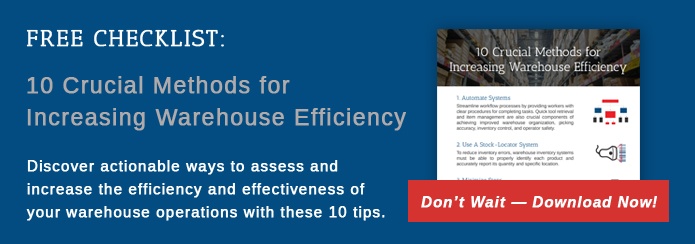 Improving warehouse operations while reducing costs is a goal for many businesses. However, with up to 70 percent of the cost of warehouse operations going towards labor, that goal can be difficult to achieve. How do you raise productivity while lowering your costs? The answer is warehouse automation software.
Improving warehouse operations while reducing costs is a goal for many businesses. However, with up to 70 percent of the cost of warehouse operations going towards labor, that goal can be difficult to achieve. How do you raise productivity while lowering your costs? The answer is warehouse automation software.
Understanding Production Rates
Before you can undertake any effort to improve productivity, you need to understand just how productive your warehouse operation really is. This information provides a baseline by which you can measure any improvements. It also gives key indications of where improvements can be made.
Productivity can be measured in many ways. Here are the top three:
- Order fulfillment: includes on-time shipments, order fill rate, and pick accuracy
- Inventory management: includes inventory accuracy and space utilization
- Labor productivity: varies by the specific operation within the warehouse (receiving, put-away, picking, shipping, etc.)
All production rates should be specific to a given task and noted in a measurable unit of time. For example, how many full pallets can a forklift operator put away on pallet racks in an hour? How many cartons can a receiving specialist unload from a full semi in an hour? How many pieces can a picker pull from a flow rack using a paper ticket in an hour?
Measuring each activity in the warehouse will tell you where you need to begin making improvements.
Implementing an Automation Solution to Improve Productivity
Once you know where you need to improve productivity, the next step is to determine how you are going to do it. Any employee-specific problems should be addressed with additional training or other measures to bring all workers up to similar productivity levels. However, retraining and replacing unfit workers will only go so far when it comes to improving productivity.
Warehouse automation is key to improving productivity while bringing down costs. When it comes to automation, most warehouses adopt one or more of the following:
- Barcoding and Paper systems
- WMS
- ERP WMS module
Each of these options helps improve productivity. However, each one of them has drawbacks as well. Paper systems and Barcoding are clunky and must be integrated with the inventory system for optimum efficiency. A WMS ERP module is usually generic, inflexible, and extremely hard to customize to a particular warehouse operation.
So What Should You Use?
A comprehensive, dedicated warehouse management system (WMS) is the better option. It replaces almost all the paperwork in your warehouse. It integrates completely with any barcoding or RF tags used in the warehouse. It can communicate with the ERP system while giving you the ability to customize it to how your warehouse is organized and how it operates.
Warehouse automation software helps improve your warehouse's efficiency in the following ways, among others:
- Tracks order fulfillment
- Tracks error rates
- Increases inventory accuracy to 99.99%
- Improves inventory management
- Optimizes workflow
- Automates replenishment
- Helps identify areas of weakness
- Tracks rates of improvement
- Gives management a view into employee productivity and performance
Implementing warehouse automation software can help you reduce your labor costs while improving your productivity simultaneously. It offers critical insight into what parts of your operation are working and what parts could use a little attention.



